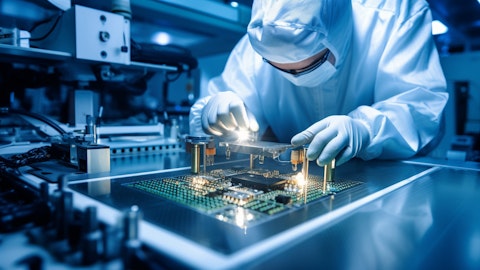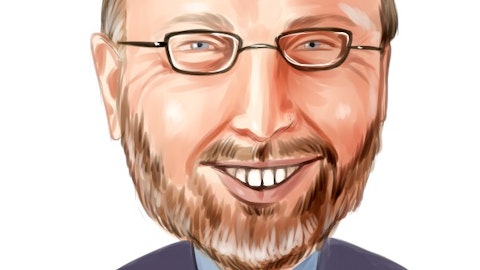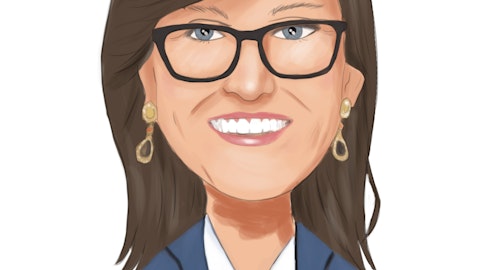Tower Semiconductor Ltd. (NASDAQ:TSEM) Q4 2023 Earnings Call Transcript February 14, 2024
Tower Semiconductor Ltd. beats earnings expectations. Reported EPS is $0.55, expectations were $0.54. Tower Semiconductor Ltd. isn’t one of the 30 most popular stocks among hedge funds at the end of the third quarter (see the details here).
Operator: Ladies and gentlemen, thank you for standing by. Welcome to the Tower Semiconductor Fourth Quarter and Full Year 2023 Financial Results Conference Call. All participants are currently in a listen-only mode. Following management’s prepared statements, instructions will be given for the question-and-answer session. [Operator Instructions]. As a reminder, this conference is being recorded February 14th, 2024. Joining us today are Mr. Russell Ellwanger, Tower’s CEO; and Mr. Oren Shirazi, CFO. I would now like to turn the conference over to Ms. Noit Levy, Senior Vice President of Investor Relations and Corporate Communications. Ms. Levy, please go ahead.
Noit Levy : Thank you, and welcome to Tower Financial results conference call for the fourth quarter and full year of 2023. Before we begin, I would like to remind you that some statements made during this call maybe forward-looking and are subject to uncertainties and risk factors that could cause actual results to be different from those currently expected. These uncertainties and risk factors are fully disclosed in our forms 20-F and 6-K filed with the Securities and Exchange Commission, as well as filings with the Israeli Securities Authority. They are also available on our website. Tower, assumes no obligation to update such forward-looking statements. Please note that the fourth quarter and full year of 2023 financial results have been prepared in accordance with U.S. GAAP.
The financial tables and data in today earnings release and in these earnings call also include certain adjusted financial information that may be considered non-GAAP financial measures under Regulation G and related reporting requirement as established with the Securities and Exchange Commission. The financial tables include the full explanation of these measures and the reconciliation of these non-GAAP measures to the GAAP financial measures. Please note, we have a supporting slide deck that compliments today’s conference call. This presentation is accessible on our company’s website and is also integrated into today’s webcast for your convenience. Now I’d like to turn the call to our CEO, Mr. Russell Ellwanger. Russell, please go ahead.
Russell Ellwanger : Thank you, Noit. Welcome everybody. Thank you for joining our call today. During today’s call, we’ll discuss our financial results for the fourth quarter and the full year of 2023, and share our strategic direction and expected growth outlook for 2024. To begin, as is known, on January 1st of this year, there was an earthquake in Japan and a surrounding area to our facilities at Hokkaido. We are grateful that no employee suffered any physical harm through this event. Due to state-of-the-art building practices, we did not suffer facility structural damage. We did suffer tools damage and scrap of some percentage of work in progress at both factories as well as secession of operations. Our dedicated and most capable employees have recovered both factories to full operation with start levels currently to the level set in the annual plan.
2023 was marked by an industry-wide slowdown resulting in an annual revenue of $1.42 billion. As we transition into 2024, there are clearer indicators of market recovery. We are realizing renewed demand across several of our key market segments. We’ll give more color on this as we continue the call. Revenue for the fourth quarter was $352 million at this revenue level Fab utilizations were Fab 1 6-inch was about 60%. Fab 2 8-inch was about 75%. Fab 3 remained at about 40%. Fab 5 8-inch was about 40%. Fab 7 12-inch was about 70%. Fab 9 8-inch was also about 70%. As a validation of our value-add products and next-generation customer-aligned roadmaps, we not only maintained our blended average selling price per layer, but saw an increase of about 4% in 2023 over 2022.
This was not due to price increases, but rather due to value-add products resulting in a richer mix and there’s a reason for maintaining good margins in a period of industry pullback. Anticipating shifting market dynamics and customer demand, we are actively optimizing our operations through a consolidation of our 6-inch activities into our 8-inch operations in Migdal, Mick Israel. As part of this optimization process, we will phase out certain lower-margin products in our 6-inch offerings, aligning to our long-term strategic goals and financial model, while porting certain activities to the Fab 2 8-inch. For example, a high-value technology serving a next-generation advanced computer tomography, CT scan machine into our 200 mm factory, ensuring continuity and even greater efficiency for this technology, which will require several hundreds of 200 mm wafers per CT machine.
A breakdown of our 2023 revenue per end market is as follows, shown in Slide 30 in the supporting slide deck. Census and displays represented 20%, RF mobile business 22%, RF infrastructure business 10%, power IC business 24%, discrete 15%, Mixed-signal CMOS 7% and there’s about 2% of miscellaneous for this period. Revenue breakdown by end market as follows, please reference slide 4. Infrastructure revenue which is predominantly RF optical with a certain amount of advanced discrete was 11%. Wireless was approximately 22%, automotive 17%, which we serve with power ICs, with discrete with imagers and with RF radar. Consumer in which we consider compute, power management for general accessories and home appliances and home use security cameras was approximately 13%, industrial about 7%, image sensors for high-end photography and medical applications about 7%.
Aerospace and defense about 4% and there was about 2% of mixed-signal CMOS where we do not have exact end market knowledge. Additionally, about 14% of power device revenue for which we do not have granularity on the exact end market application, which serve multiple of the above-mentioned segments such as automotive, industrial, wireless and consumer. And lastly, an additional 3% divided among the end markets that we’ve spoken, but of which we cannot granulize. Specific on RF mobile we are experiencing a rebound in the mobile market running presently at high utilization for both 200 mm and 300 mm RF SOI capacity with additional capacity coming online throughout 2024 and 2025. Our capacity planning is and will continue to pay off having met our initial targets at the Agrate, Italy facility, having qualified and shipped our first products with a planned ramp throughout this year, supported by an already executed double-digit number of production tape-outs to meet the increasing demands shown in our customers forecasts.
Wisely partnering with ST and hence leveraging the ST build out we reduced the impact on margins of a new manufacturing activity, but as is in any new capacity ramp from scratch, there is an initial headwind on margins. This should be fully absorbed and become accretive margins within the first half of 2025 the planned completion of the present phase capacity to ramp in the Agrate facility. Looking forward, we are prototyping new 200 mm and 300 mm technologies, please see slide five, with best in industry efficiency as measured Mr. Oren Shirazi [ph] and output power as measured by breakdown voltage, winning new customers and design slots while beginning conversations with customers about 6G requirements. Prior to the adoption of new wireless standards such as 6G we see additional AI and mobile AR, VR applications having the potential to drive a stronger handset refresh market over the next several years to further benefit our RF business.
RF infrastructure, we are strongly positioned supplying AI infrastructure growth in part by our previously announced silicon photonics partnership with Inner Light, the global number one optical module provider and Marvell, a tier one optical connectivity provider as well as with a total of over 50 additional customers currently using our silicon photonics foundry platform. In addition to our current silicon photonics production supplying 400G and 800G AI, data center and Datacom infrastructure, we are investing with our lead customers in new technologies, enabling more efficient 1.6 T systems through innovation in both materials and architectures, including options for co-pack optics. We continue to expand the silicon photonics application space by working with leaders in automotive and commercial LiDAR to enable silicon photonics based future frequency modulated continuous wave that can create solid-state cost-effective LiDAR solutions with better resolution capability than possible with other technologies.
Please see slide six. Leveraging our incumbent position, we continue to work with our previously announced silicon Romanian customers, including MACOM, Broadcom, and Semtech and many others to develop next generation optical components for pluggable transceivers, active cables, and for LPOs, linear programmable optics to not only support faster data transmission rates for single wavelength, but also to reduce latency and power consumption for data centers supporting generative AI and machine learning applications. Finally, we just recently announced our partnership with Renaissance, a global conglomerate and market leader in supporting the rapidly growing satellite broadband market. Today, our silicon germanium products can go into beam former terrestrial and antenna terminals where each user terminal requires more than 250 silicon germanium transceivers.
For reference, please see slide seven and eight. Longer term, the industry is exploring ways to incorporate satellite reception into [Indiscernible] which could create an even larger market opportunity, including a change of cadence and next generation mobile platform refresh adoption. With multiple fab qualifications for silicon germanium, we are well-positioned to support the capacity needed for these expanding markets. Looking at our power business, while 200 mm power is undergoing some level of inventory correction driven in part by automotive, we continue to see very strong demand for 300 mm power management BCD platforms, where advanced power performance and increased digital processing creates the ideal match for the smaller sizes needed for power, audio, battery management ICs with a broad feature catalog pick and choose modular platform.

Please see slide nine. In addition, the advanced power performance makes it an excellent technology solution to deliver high power to computing processors and AI accelerators within data centers. This platform fits many power mix signal application and is therefore being chosen by Tier 1 companies for a wide range of applications, which are now running at high volume in our Uozu factory in Japan. We have recently delivered successful first silicon from our most advanced and feature rich 65 nanometer BCD platform to a Tier 1 customer and are working together bringing initial products to market on this most advanced platform. Regarding progress in Albuquerque, we have initial full flow material completed, while making meaningful progress in qualifying the technology to enable further wrap of both existing customers, as well as new high-volume power and mixed-signal customers, and we’ll begin customer prototyping in the second half of 2024 towards full qualification and production in 2025, and obviously beyond.
Moving to sensors and displays, our machine vision market is expected to get back to high demand levels in 2024. This rebound is mainly driven by the Chinese machine vision camera market where our customers and their customers are gaining significant share in factory automation and embedded robotic camera systems. For this market, we are completing the development of a small pixel global shutter roadmap, scalable to various resolutions from mainstream of five megapixel to 12-megapixel sensors to very high-resolution sensors of up to 325 megapixel enabled by our advanced proprietary stitching technology, printing sensors larger than the lithography frame size, please see Slide 10. In the medical market, we’ve developed a new 12-inch 65 nanometer length flow as a comparative answer to non-CMOS, non-silicon IGZO, Indium Gallium Zinc Oxide, thin foam transistor technology.
Please reference Slide 11. This enabled customers to retain the high performance of CMOS imagers, namely low dose x-ray sensitivity and high frame rate at cost level now competitive to IGZO. As mentioned, as a key technology being moved from 6-inch to 8-inch, we are producing new photon counting sensors for next-generation CT scanner, a new market for us with a Silicon Sam of about $300 million. In this market, we partner with an absolute leader to provide a unique technology, which allows scanning at lower doses with much higher resolution due to energy separation. In addition, we are expanding our high-end photography portfolio, capitalizing on our leadership position and learnings in the cinematography and broadcasting market, where in one instance, the end customer is an iconic industry leader.
Revenue guidance for the first quarter of 2024 is $325 million plus minus 5% in line with industry seasonality and in spite of the impact of the earthquake in Japan. Looking throughout 2024, we target notable quarter over quarter sequential growth. We left 2023 with multiple powerful doors having been opened, catalyzed through the unrealized merger deal. Tower is in the best position in its history based upon financial strength, technical offerings, operational performance tied with growing operational capacity, and backed by strategic customer partnerships, the strength of which cannot be overstated. We enter 2024 with strong focus on strategic value add growth, addressing both immediate and longer-term objective. What is the strategic value-add growth based upon?
Market expansion with growing capacity and innovation, both based upon strategic partnerships. For market expansion, we continue intensifying our efforts in several markets where we see substantial demand and opportunities. RF infrastructure with very strong focus on Silicon Photonics and a complete power offering, our two areas poised for robust growth that we are well positioned to serve. Innovation, in order to meet the evolving needs of customers and to outpace the competition, innovation remains at the core of our value proposition. In this call, we’ve discussed several areas of best in industry figures of merit. Strategic partnership, we believe in the superal power of collaboration. We are expanding our partnerships with existing customers, leaders in their respective markets as well as new customers with ideas and excitement, pausing them to become leaders as well.
With that, I’m pleased to turn the call to our CFO, Mr. Oren Shirazi. Oren, please.
Oren Shirazi: Hello everyone. We released today our total and annual financial results. For Q4 ‘23 we reported revenues of $352 million, gross profit of $84 million and net profit of $54 million. For the full year we reported revenues of $1.42 billion, gross profit of $354 million and net profit of $518 million, which included $290 million net profit impact of the merger contract termination fee received from Intel. I will start my review by analyzing the P&L highlights followed by our balance sheet and CapEx plans. Revenue for Q4 was $352 million as compared to $358 million in the prior quarter, and gross profit for Q4 was $84 million as compared to $87 million in prior quarter. Operating profit for Q4 was $45 million and net profit was $54 million or $0.49 basic and $0.48 diluted earnings per share.
Operating and net profit for the third quarter included the net impact of merger contract termination fee we received from Intel in the amount of $314 million net of associated cost included in operating profit, and an amount of $290 million net of tax included in net profit, based on a 7.5% preferred income tax rate as applicable to us in Israel. Including the termination fee operating profit for the third quarter was $362 million and net profit was $342 million or $3.10 basic, and $3.07 diluted earnings per share. For the full year revenue was $1.42 billion as compared to $1.68 billion in 2022, and gross profit was $354 million as compared to $466 million in ‘22. Operating profit for the full year was $547 million and included $314 million net from the Intel merger contract termination fee compared to operating profit of $312 million in ’22.
Net profit for the full year was $518 million or $4.70 basic and $4.66 diluted earnings per share and included $290 million net due to the payment by Intel of a merger contract termination fee compared to net profit of $265 million or $2.42 basic and $2.39 diluted earnings per share in 2022. Moving to the balance sheet and future CapEx and cash plans, our balance sheet as of the end of December, 2023 totaled $2.9 billion, primarily comprised of $1.2 billion of fixed assets, mostly machinery and equipment and $1.7 billion of current assets. Current assets ratio reflecting the multiple by which current assets are larger than short-term liabilities is very strong by a multiple of 6.2x as compared to 3.9x as of the end of ’22. Shareholders’ equity increased by 29% as compared to its amount at the end of ‘22 and reached a total of $2.4 billion.
Our strong financial position enables us to plan the following investment in strategic opportunities that are aligned to our vision. approximately $500 million of total aggregate cash was allocated to make investments in equipment and other CapEx items required for the 12-inch factory in Agrate, Italy. Following the previously announced STmicron partnership agreement signed in 2021, we already invested $100 million in ‘22, an additional $200 million in ‘23, and the remaining $200 million will be paid during ‘24 and ‘25. In addition, as previously announced, we will invest up to $300 million to buy equipment and other CapEx items that we will own in Intel Feb in New Mexico, enabling Tower to ramp up this Feb capacity and capabilities for our customers.
In addition, we expect our maintenance CapEx baseline level to remain as previously announced at about $200 million per annum. And lastly, we expect to invest additional cash to acquire more capability CapEx tools and other assets to expand our future technology offering, including increasing our 5G and CIFO capacity and technological offering to enhance our flexibility to support our customers from our different sites and change our product mix to result in a richer mix from a margins perspective. All the above is aligned to our business strategy as well as our financial model as presented by the company in our pre-call in November, which financial model outline our revenue target of $2.66 billion per annum that could be achieved by loading our existing factories at 85% utilization, and that should result in $500 million annual net profit based on the specified assumptions that were outlined.
Now, I’d like to turn the call back to our CEO, Mr. Russell Ellwanger.
Russell Ellwanger: Yes, maybe we would open up to questions and from there we can go ahead and I’ll give a closing.
See also 13 Countries with Easy Citizenship for Retirement and 25 Most Spoken Second Languages in the World.
Q&A Session
Follow Tower Semiconductor Ltd (NASDAQ:TSEM)
Follow Tower Semiconductor Ltd (NASDAQ:TSEM)
Operator: [Operator Instructions]. The first question is from Cody Acree of Benchmark. Please go ahead.
David Williams : This is actually David Williams on for Cody this morning. Well thanks for all the great color, as usual, but wanted to dig in a bit on the impact on the revenue side and maybe even on the margins from the transition or the shutting down of that 6-inch and moving to 8-inch. Seems like there should be some nice margin tailwinds there, but also just kind of what that revenue impact could look like over the next couple of quarters as you port that over.
Oren Shirazi: Yes. it’ll not impact the margins at all. This Feb 1 because, anyway, that’s the oldest Feb we had built 40 years ago in 1984. it was very nice, highly utilized. But in recent year or two, it’s about at the breakeven point, so it did not really contribute to the margin. So, there will not be any deficiency to the margin. So, it’ll be pretty much break even, the revenues we didn’t disclose publicly, but it’s immaterial really to the total amount and it’s already baked into our financial model that’s represented in previous time.
David Williams: It seems like that might have been margin dilutive and you might get a tailwind from that and in addition to the economics of moving that from that 6-inch to the eight inch, is that fair to say?
Oren Shirazi: It is, but over the next few quarters it actually — we’ve been well aligned with customers and getting prepared for this and if anything, revenues will be higher through some pullins of end life activities. So, over the next two, three quarters, if anything it’s going to be beneficial, not negative, but on a small level.
David Williams: And then maybe just on the rebound that you’re talking about, what is maybe can you point to that’s giving you that confidence? Is it really the near-term order rates that are forecasting customers or are you getting better longer-term visibility of the customer demand?
Oren Shirazi: That’s a combination of both, had stated that we’re targeting notable quarter-over-quarter growth throughout the year. If we look at our forecasts, on most all of the core businesses that we have, there’s good strong double-digit growth in the year, but really driven off of the second half, not very much off of the first half with the exception right now, the RFSOI is very strong and as well we have certain mixed signal and power also going into mobile platforms that’s very high at the moment. So, two areas of really increase in forecast had mentioned that I think fortuitous but based upon good planning, when we started the activity in Italy, the Agrate facility, we had by plan going to be shipping our first — wafers in the fourth quarter of 2023.
And that is right now an area where we really do need capacity and as the capacity is coming online, quarter over quarter, it’s fully spoken for throughout this year and by forecast for the 2025 as well when it hits the full capacity of this ramp phase in the second quarter of 2025. So, in the area of the RFSOI and some other mobile applications, we have seen a very big pickup in orders in the area of Silicon Germanium and Silicon Photonics, we see very strong forecasts for which we’ve not yet received the pos, but really in Q2, Q3, Q4, and that’s very real. If I look at — year over year growth in Silicon Photonics by forecast is multiple hundreds of percent. And then our 300 mm power is also very strong growth year over year as well as the 300 mm mix signal, which is serving some of these mobile applications that I had said, if I look again at our core CIS activities had mentioned the industrial sensors and that’s doubling from present run rate in Q3, Q4.
Now as say these are customer forecasts, they’re not yet IPOs, but our customers are pretty good about forecasting and, we are fairly good about what we put in the system. So, across many of our segments, we see very strong growth coming in this year, but backed in the second half. And that’s what gets us very exciting is that, either with new technologies that are now gaining new market shares for us and for our customers or a rebound in the market itself, both have the same accretive benefit on revenue and ultimately on margins. The one area that we do have weakness now, we don’t see an increase coming quickly is that of our 200 mm power management predominantly being done in our factory in Tanami, Japan. And I think, you know, anyone that looked at the TI release knows that, you know, they’re, I think TI is a pretty good bellwether of across the board power management.
That market is weak right now, and a big portion of what was being served in that market for us was automotive and particular battery management. And that has pulled back. So that’s the one area that I don’t see yet by customer forecast, a rebound, but most everything else that we’re doing, I think looks very good, at least in the second half and some already having started in the first half. Hopefully that answers your question. I tried to make it very complete.
David Williams: No, very, very great color. Thanks. Thanks for that, Russell. And then maybe just one last one for Oren. Just kind of given the trough that we’re seeing in revenue next quarter, how should we think about the gross margin and just given the mix and that revenue base there and all the moving pieces and I appreciate the help here and thank you.
Oren Shirazi: Yeah, I believe you should, uh, assume that the baseline of Q4 actual which resulted in I believe 24% gross profit is the baseline and for Q1 and now since the revenue guidance is indicating about 25 million, 27 million lower revenue, so then you should apply the 50% incremental model whether we go up or down.
David Williams: Great. Thanks again.
Oren Shirazi: Thank you. Good question.
Operator: The next question is from Richard Shannon of Craig Hallum. Please go ahead.
Richard Shannon: I’m actually going to follow up on the gross margin question. I appreciate the thoughts here, Oren as to how to think about the first quarter here. I think I heard from one of you two about some sort of impact here from the SC micro fab ramping up here. I’m wondering, what that effect might be because it doesn’t seem like you’re necessarily seeing it here in the first quarter. How do we think about that? And then as the lower margin products in Fab One roll off, does that give us any thought process for a higher feeling of gross margins in your model? I think I heard you say no, Oren, but I just want to make sure.
Oren Shirazi: Yeah, I think my previous answer that to assume 50% incremental on the revenue increase or decrease is considering all that, meaning let’s say if currently, the gross profit was whatever it was, $84 million and if one assumes 25 million revenue reduction, so it should be attributed to 50% of that gross profit. Instead of 84%, 50% of 24. So, it’s $72 million. Yes, what Russell mentioned is true about the fact that we will start, since we start, like Russell said from scratch, the gut factory, it will — until it’ll reach the breakeven point, which Russell indicated in a year from now, may influence a little bit on the margins. We didn’t specify the amount. It could be some lower margins, but it’ll be offset by other activities and richer mix. So, I think it’s already in the number that is specified before.
Richard Shannon: Okay. Fair enough. Thanks for that clarification, Oren. Russell, kind of going on your press release and your comments here on the call about notable growth after this first quarter here and you’re clear on saying more in the second half here, trying to put numbers together and think about the total year. I think that the fair question to ask here is do you think you are going to grow your total revenues in ‘24 of to ‘23? It seems like it’d be right in that range, but just want to get a sense of how do we interpret notable?
Russell Ellwanger : I would expect that we grow our revenue ‘24 over ‘23. Yes.
Richard Shannon: Excellent. That’s great to hear. Let’s hear maybe a couple of questions in…
Russell Ellwanger : I’ll actually be very disappointed if we don’t.
Richard Shannon: Excellent. Well that’s great to hear. Quick question on the data center area here. It sounds like you’re seeing some pick up here, but want to get a sense of kind of exposure in some of the growth drivers. Here you talked about higher end datacom and 800G. I’m wondering if you could, there’s any way that where you can quantify how much your business is 800G and then you have talked about today and in the past about linear pluggable optic LPO. Is that you think that’s going to be a sizable part of the market down the road?
Russell Ellwanger: What I think is a necessarily that critical, yes, I believe that there’s major advantages in it that should be implemented, how big it will get. I don’t know. I think it could, and it does have benefits. It certainly would be beneficial for us in the offerings that we give, but I’m not a market analyst. I think, that’s really more of a question for you than me, but it’s — from the technical benefit, yes, I think that there’s strong benefit there. As far as what you said about data center, though, I did want to state what I have not yet seen other than in silicon photonics. We have not yet seen a big uptick in POs, we’ve seen an uptick in forecast, and there’s a sometimes a difference between the two. But I’m confident in the forecast and that we’ll be picking up in the second, third and fourth quarter as far as POs and ultimately shipments.
For what we’re doing in the — with our customers and what’s being done in the end customer. I was delightfully surprised in a executive meeting with a big integrator in the second half of ‘23 to hear how much of their present volume is going into 800G, and it was certainly much higher than the standard analyst reports were saying was 800G. That’s I think very obviously driven by AI. So how much is now going at 800G? I would, again, that’s an overall market analyst statement, not mine, but quite a bit of what we’re shipping will be going into that, I believe most all of what we’re doing in SiPho is added at the 800G and obviously targeting into 1.60.
Richard Shannon: Okay, that’s helpful. Two quick questions. I will jump out of line. You’ve talked very positively about silicon photonics, and I think it’s a very, I think it’s a very small piece of your revenues within the company, much less in data center. How can we think about this over the next couple, few years? Big picture about how much this becomes part of your data center business. I don’t know if you’d want to get a percentage of that business and how fast that can grow or just any context of this area that you seem very excited about.
Oren Shirazi : So, I see by all of our own plans and by customer alignments, SiPho, will be a predominant portion of data center market and elsewhere as well. But data center definitely, and realize that we have both passive and active SFO. The activity that we have going on integrated laser is pretty exceptional and we are the only pure play foundry that has that. And those are very, very high dollar, high-value systems as well as what we’re doing now with SiPho that, for example, we’re shipping to InLight. But I wouldn’t say that it’s an insignificant amount of our revenue presently. If I look at what we’re having in our forecast for ‘24, the SiPho revenue is not insignificant.





